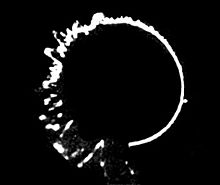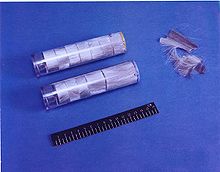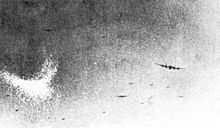- Chaff (countermeasure)
-
Chaff, originally called Window[1] by the British, and Düppel by the Second World War era German Luftwaffe (from the Berlin suburb where it was first developed), is a radar countermeasure in which aircraft or other targets spread a cloud of small, thin pieces of aluminium, metallized glass fibre or plastic, which either appears as a cluster of secondary targets on radar screens or swamps the screen with multiple returns.
Modern armed forces use chaff (in naval applications, for instance, using short-range SRBOC rockets) to distract radar-guided missiles from their targets. Most military aircraft and warships have chaff dispensing systems for self-defence. An intercontinental ballistic missile may release in its midcourse phase several independent warheads, a large number of decoys, and chaff.
Chaff can also be used to signal distress by an aircraft when communications are not functional. This has the same effect as an SOS, and can be picked up on radar. It is done by dropping chaff every 2 minutes.
Contents
Second World War
The idea of using chaff developed independently in the UK and in Germany.
As far back as 1937, R. V. Jones had suggested that a piece of metal foil falling through the air might create radar echoes.[2] In early 1942, a Telecommunications Research Establishment (TRE) researcher named Joan Curran investigated the idea and came up with a scheme for dumping packets of aluminium strips from aircraft to generate a cloud of false echoes.[3] From a practical point of view it was found the most effective version were strips of black paper backed with aluminium foil cut to strips exactly 27 centimetres by 2 centimetres and packed into bundles each weighing one pound .
The Head of the TRE, A. P. Rowe, code-named the device as "Window".
Meanwhile in Germany, similar research had led to the development of Düppel.[4] Once the idea had been passed to the US, Fred Whipple developed a system (according to Harvard Gazette Archives) for dispensing strips for the USAAF, but it is not known if this was ever used.
The systems were all essentially identical in concept: small aluminium strips (or wires) cut to one-half of the target radar's wavelength. When hit by the radar, such lengths of metal resonate and re-radiate the signal.[5] Opposing defences would find it almost impossible to pick out the "real" aircraft from the echoes from the chaff. Other radar-confusing techniques included Mandrel,[6] Piperack, and Jostle.
However, unaware of the opposing air force's knowledge of the chaff concept, planners felt that using it was even more dangerous than not, since, as soon as it was used, the enemy could easily duplicate it and use it against them. In particular, the British government's leading scientific adviser, Professor Lindemann, balefully pointed out that if the RAF used it against the Germans, the Luftwaffe would quickly copy it and could launch a new Blitz. This caused concern in RAF Fighter Command and Anti-Aircraft Command, who managed to suppress the use of Window until July 1943.[7] At this time, it was felt the new generation of centimetric radars available to Fighter Command would deal with any Luftwaffe response to RAF Bomber Command use.
Examination of the Würzburg radar equipment brought back to the UK during Operation Biting and subsequent reconnaissance revealed to the British that all German radars were operating in no more than three major frequency ranges, and thus were prone to jamming. "Bomber" Harris, Commander-in-Chief (C-in-C) of RAF Bomber Command, finally got approval to use Window as part of Operation Gomorrah, the fire raids against Hamburg.
The first aircrew trained to use Window were 76 squadron. Twenty-four crews were briefed on how to drop the bundles of aluminised-paper strips (treated-paper was used to minimise the weight and maximise the time that the strips would remain in the air, prolonging the effect), one every minute through the flare chute, using a stopwatch to time them. The results were spectacular. The radar guided master searchlights wandered aimlessly across the sky. The AA guns fired randomly or not at all and the night fighters, their radar displays swamped with false echoes, utterly failed to find the bomber stream. A vast area of Hamburg was devastated with the loss of only 12 bombers. Squadrons quickly had special chutes fitted to their bombers to make the deployment even easier. Seeing this as a development that made it safer to go on ops, many crews got in as many trips as they could before the Germans found a countermeasure.
 The effect of chaff on the display of a Giant Würzburg radar. The effect of jamming appears in the left "jagged" half of the circular ring, contrasting with the normal "smooth" (unjammed) display on the right half of the circle, with a real target at the 3 o'clock position - on the jammed left side the real target "blip" would have been indistinguishable from the jamming.
The effect of chaff on the display of a Giant Würzburg radar. The effect of jamming appears in the left "jagged" half of the circular ring, contrasting with the normal "smooth" (unjammed) display on the right half of the circle, with a real target at the 3 o'clock position - on the jammed left side the real target "blip" would have been indistinguishable from the jamming.
Although the metal strips puzzled the German civilians at first, the German scientists knew exactly what they were because they had developed Düppel themselves and refrained from using it for exactly the same reasons as Lindemann had pointed out to the British. Thus for over a year the curious situation arose where both sides of the conflict knew how to use chaff to jam the other side's radar, but refrained from doing so fearing that if they did so the other side would 'learn the trick' and use it against themselves.
The use of Window rendered the ground-controlled 'Himmelbett' (German for "canopy bed") fighters of the Kammhuber Line unable to track their targets in the night sky and left radar-guided guns and spotlights useless. In response to this, a new tactic, called Wilde Sau, or 'Wild Sow', was developed by Oberst Hajo Herrmann to cope with the lack of accurate ground guidance, and led to the creation of three new fighter wings dedicated to these tactics, numbered JG 300, JG 301 and JG 302. Ground operators would radio-direct single seat fighters and night fighters to areas where the concentrations of chaff were greatest (which would indicate the source of the chaff), and allow the fighters to visually acquire their targets, often against the fires and searchlights below. A few of the single seat fighters used by these new wings had special installations of the FuG 350 Naxos radar detection gear to spot British bombers at night.
A lesser known fact is that the Luftwaffe used this technology just six weeks after the above-mentioned Hamburg raid. The German strips were cut into 80 centimetre by 1.9 centimetre lengths and first dropped during a raid on 7-8 October 1943.[8] In a series of raids in 1943, and the 'mini-blitz' of Operation Steinbock between February and May 1944, Düppel allowed German bombers to once again attempt to operate over London. Although theoretically effective, the small number of bombers, notably in relation to the RAF's now-large night fighter force, doomed the effort from the start. The British fighters were able to go aloft in large numbers and often found the German bombers in spite of their Düppel.
Falklands War
Chaff was heavily used by British warships in the Falklands War.
During the war, British Sea Harrier aircraft lacked their conventional chaff-dispensing mechanism.[9] Therefore Royal Navy engineers designed an impromptu delivery system of welding rods, split pins and string, which allowed six packets of chaff to be stored in the airbrake well and be deployed in flight. It was often referred to as the "Heath Robinson chaff modification", due to its complexity.[10]
See also
- Countermeasure
- Infrared countermeasures
- Flare (countermeasure)
- Electronic countermeasures
- Anti-aircraft
- Anti-ballistic missile
Notes
- ^ Churchill, Winston Spencer (1951). The Second World War: Closing the Ring. Houghton Mifflin Company, Boston. pp. 643.
- ^ Jones. p.290
- ^ Goebel. section 8.3 The British Begin Countermeasures
- ^ The German code name was that of the estate on which the first German tests with chaff had been made, circa 1942. Jones. p.299
- ^ Jones. p.291
- ^ Mandrel was an airborne jammer targeted at the German Freya radars. Jones. p.295
- ^ Jones. pp.291-299
- ^ The Blitz-Then and Now (Volume 3) page 309.
- ^ Sharkey Ward (2000). Sea Harrier Over the Falklands (Cassell Military Paperbacks). Sterling*+ Publishing Company. p. 245. ISBN 0-304-35542-9.
- ^ Morgan, David L. (2006). Hostile Skies: My Falklands Air War. London: Orion Publishing. pp. 59, 73 and photo section. ISBN 0-297-84645-0.
References
- Goebel, Greg. The Wizard War: WW2 & The Origins Of Radar v.2.0.2, retrieved 2008-03-18
- Jones, R. V. (1978). Most Secret War: British Scientific Intelligence 1939–1945. Hamish Hamilton, London. ISBN 0-241-89746-7
External links
RAF strategic bombing during the Second World WarOverviews Leaders Campaigns Operations Aircraft Tactics See also Aerial defence of the United Kingdom · United States Army Air Forces (USAAF) · List of Battle of Europe air operations · Defense of the Reich
Categories:- Military technology
- Weapons countermeasures
- World War II Allied electronics
- World War II British electronics
- British inventions
Wikimedia Foundation. 2010.


